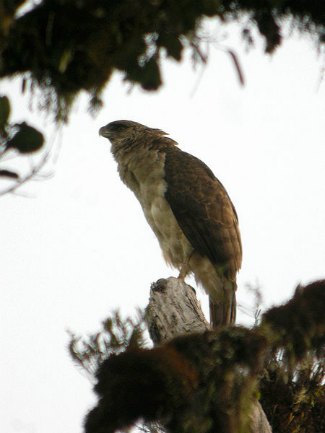New Guinea Harpy Eagle - Harpyopsis novaeguineae
By markaharper1, CC-BY-SA-2.0, via Wikimedia Commons
Family: Accipitridae
Genus: Harpyopsis
Species: H. novaeguineae
New Guinea Harpy Eagles are large, semi-nocturnal raptors that are endemic to the island of New Guinea. They form a clade with the genera Harpia (Harpy Eagle, Harpia harpyja) and Morphnus (Crested Eagle, Morphnus guianensis).
Physical Description:
New Guinea Harpy Eagles are gray-brown from above with a cream-colored underside and a brown-spotted throat and chest. The tail has four to five black bars, a thick subterminal band, and a white tip. They have a short bushy crest and a facial ruff that may serve to focus sound, similar to the facial disc of owls. The eyes are brown-orange and the cere and beak are black.
Juveniles are a paler gray-brown and have buff underparts. The tail has seven to eight bars.
Their calls are short, irregular barking sounds that can carry far through the forest. Pairs often duet around dawn and dusk, and also at night. Listen to a New Guinea Harpy Eagle.
In captivity they have been known to live for over 30 years.
Size:
Length: 79-90 cm
Wingspan: 157-200 cm
Weight: 1.6-2.4 kg
Habitat and Distribution:
They live in primary, gallery, and montane forest from 0-3,700 meters above sea level. They are semi-nocturnal, unlike most eagles.
They are endemic to the island of New Guinea from 0° to 11°S. Adults are sedentary, but juveniles disperse from breeding areas. There are an estimated 2,500-9,999 individuals over a range of 734,000 km².
Diet and Hunting:
They eat mammals, birds, and reptiles. Mammalian prey includes both arboreal and terrestrial species, such as ringtail possums, cuscuses, forest wallabies, tree kangaroos, pigs, and dogs. There was a local reported instance of a New Guinea Harpy Eagle carrying off a child into tree, but the story is impossible to verify with any certainty. Their alternative name of "Kapul Eagle" comes from their habit of hunting kapuls, a type of marsupial.
They have a range of forest hunting methods. They still-hunt from a perch, flying to different locations through the forest or above the canopy and listening for prey; they hunt on the ground, running and jumping, with their wings partially open so they can launch into the air; and they will flush prey out of epiphytic foliage by shaking it, striking with their wings, or tearing at it with their beak and claws.
Reproduction:
Breeding displays do not consist of any aerial displays—another way in which they are dissimilar from many other eagles—and mostly consist of calling. The breeding season is from April-August, during the last of the wet season and the start of the dry season.
The nest is built out of sticks and epiphytes and can be up to 3 m across and 3 m deep. It is placed in the crown of a tall tree with few low branches. Nests are often reused for many years if breeding is successful. Clutch size is one egg. Incubation and nesting periods are unknown. Adults breed about once every two years, due to extended juvenile dependency after the young have fledged.
Conservation:
New Guinea Harpy Eagles are threatened by habitat destruction from logging and the hunting of their feathers for ceremonial headdresses. The population is assumed to be declining and they are currently listed as Vulnerable by BirdLife International.
Conservation measures undertaken include legal protection in Papua New Guinea. Conservation measures proposed include determining the eagles' territory size, locating nests, conducting further research into their ecology, monitoring the population, investigating the level of hunting, and enforcing protection in existing reserves.
Taxonomy:
Based on the molecular sequences of one nuclear intron and two mitochondrial genes, it was found that that the genera Harpia (Harpy Eagle, Harpia harpyja), Morphnus (Crested Eagle, Morphnus guianensis) and Harpyopsis form a clade.
Other Names:
Kapul Eagle, New Guinea Eagle, Papuan Eagle, Papuan Harpy Eagle, Orel harpyjovitý (Czech), Harpij-arend (Dutch), Papuanharpyija (Finnish), Aigle de Nouvelle Guinée (French), Papuaadler (German), Elang Irian, Rajawali Papua (Indonesian), Arpia della Nuova Guinea (Italian), Harpia papuaska (Polish), Papuaørn (Norwegian), Harpia papuaska (Polish), Arpía Papúa (Spanish), Papuaörn (Swedish).
Other Multimedia:
None available.
References:
http://www.arkive.org/new-guinea-harpy-eagle/harpyopsis-novaeguineae/
http://avibase.bsc-eoc.org/species.jsp?avibaseid=1076B5CE081D1D2A
BirdLife International (2012) Species factsheet: Harpyopsis novaeguineae. Downloaded from http://www.birdlife.org on
24/01/2012.
Global Raptor Information Network. 2012. Species account: New Guinea Harpy Eagle Harpyopsis novaeguineae. Downloaded from
http://www.globalraptors.org on 24 Jan. 2012
http://ibc.lynxeds.com/species/new-guinea-eagle-harpyopsis-novaeguineae
BirdLife International 2008. Harpyopsis novaeguineae. In: IUCN 2011. IUCN Red List of Threatened Species. Version 2011.2.
www.iucnredlist.org. Downloaded on24 January 2012.
http://www.planetofbirds.com/accipitriformes-accipitridae-papuan-eagle-harpyopsis-novaeguineae
Ferguson-Lees, James, and Christie, David A. Raptors of the World. Houghton Mifflin Company, 2001.
